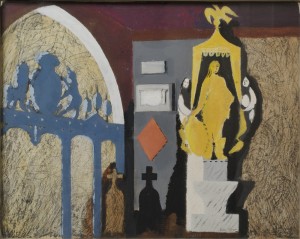Although the Manor House of Battersea, the home of several noteworthy 17th and 18th century St.John family members, was demolished in the early 20th century, there remains a strong link between Battersea and Lydiard Park, with both churches (both named St. Mary's) adjacent to the site of the homes sharing many similarities. Many legends surround the history of Battersea, including wishful tales of Pope and Swift spending time in the glorious wood-panelled library. Extensive evidence remains of Sir Walter St.John and Lady Johanna St.John's time at Battersea during the Restoration, including letters to Lydiard with instructions for supplies and plantings in its gardens, as well as a glimpse of their social standing - such as news of entertaining the newly-restored King Charles II to dinner.
In 1700, Sir Walter endowed a school for twenty poor boys from the parish of Battersea, leaving it well provided for in his will a few years later. The Sir Walter St.John School building was demolished and rebuilt in 1858, and was subsequently acquired to become Thomas's London Day School, where the young Prince George and Princess Charlotte attended as pre-prep children. Extensive historical research into the Manor and Church of St. Mary's was undertaken by schoolmasters J.G. Taylor and Frank Smallwood in the 19th and 20th centuries, much of which forms the foundational Battersea content of the Friends' Reports and Lydiard Archives, as well as the fascinating tome "Our Lady of Battersey."
The history of Battersea is rich and vivid, and has been captured extensively from Victorian times. The parish lies in the hundred of Brixton, and is situated on the River Thames, about three miles from Westminster Bridge. The name has undergone several changes, the original meaning of which is lost in the mists of time. Originally thought to be named "Batrices ege" in Saxon times, in the Conqueror's Survey, it is called Patricesy; and has since been written Battrichsey, Battersey, and Battersea, each variation carrying it still farther from its original signification, which was "Patrick's Water". Long a hub for the market gardeners supplying London's fruits and vegetables, the Parish of Battersea is bounded on the east by Lambeth; on the south by Camberwell, Stretham, and Clapham; on the west by Wandsworth; and on the north by the river Thames.
The Manor of Battersea, which before the Conquest belonged to Earl Harold, was given by the Conqueror to Westminster Abbey, in exchange for Windsor. After the dissolution of monasteries, the manor was reserved in the hands of the crown; a lease of it was granted to Henry Roydon, Esq. by Queen Elizabeth, for twenty-one years, in the eighth year of her reign; it was afterwards granted for the same term to his daughter, then Joan Holcroft; it was assigned, amongst others, for the maintenance of Prince Henry, An. 1610, heir to King James. In 1627 it was granted in reversion to Oliver St. John, Viscount Grandison, who had married Joan.
Lord Grandison died in 1630, and was succeeded in that title, and in the Battersea estate, by William Villiers, his great-nephew, who died of a wound received at the siege of Bristol. In 1644. Sir John St.John, Bart. nephew of the first lord Grandison, inherited Battersea; from him it passed in a regular descent to Sir Walter St. John, Bart., to Sir Walter's son, Henry Viscount St. John; and to his grandson Henry Viscount Bolingbrooke, who, by an act of parliament passed before his father's death, was enabled to inherit his estate, notwithstanding his attainder: the estate and manor continued in the St. John family till 1763, when it was bought in trust for John Viscount Spencer.
An extensive history of the Manor can be found within The Lydiard Archives at:
https://www.thelydiardarchives.org.uk/item/battersea-extract-from-survey-of-london-vol-49
Sources: British History Online; Our Lady of Battersey (J.G. Taylor)





